 |
Tullio Garbari: Les Intellectuels au café (The Intellectuals in the cafe) 1916 Geneva,
musée du Petit Palais |
Where can you see an aeroplane, a Josephine Baker rag doll, Cartier diamond jewellery and a bicycle wheel attached to a stool...along with examples of Cubist, Futurist and art deco creations?...in the Petit Palais "Paris Modernité" exhibition. This is the last of their "Modern Paris" trilogy. 400 works have been loaned from Paris museums and abroad to capture the effervescent atmosphere from 1905 to 1925.
 |
| Peugeot automobile 1913 |
 |
| Kees Van Dongen: Nini, danseuse aux Folies-Bergères (Nini, dancer at the Folies-Bergères) 1907-8 Pompidou Centre |
The visitor is transported to the Belle Epoque, then, after a short passage through the tragedy of World War One, to the roaring twenties.. in French "Les années folles" (the crazy years)
It starts with the two crucibles of creation: Montmartre and Montparnasse. It finishes with the art deco architecture of the twenties.
 |
Le Lapin Agile (The Agile Rabbit) cabaret sign by André Gill 1875 Private Collection
|
At the beginning of the 20th century, artists lived in Montmartre, on the Northern periphery of Paris. The Agile Rabbit cabaret (still functioning) was a meeting place for bohemia. Its irreverent setting produced a work by a 'new unknown artist'- in fact it was painted by a donkey's tail dipped in paint:
 |
Et le soleil s'endormit sur l'Adriatique (Sunset over the Adriatic) Joachim-Raphaël Boronali 1910
Espace culturel Paul-Bedu, Milly-la-forêt |
The painting was accepted at the Independents' Salon of 1910 and sold for a respectable sum. The artist claimed to be a member of the "Excessive" movement! Then the hoax was revealed. It was really the work of Lola the donkey, as witnessed by bailiffs. One of the artists who frequented the cabaret was Pablo Picasso, living at the time in the Bateau-Lavoir (Washing boat)- one of several ramshackle studios on the hill of Montmartre, where he elaborated his innovative painting Les Demoiselles d'Avignon (In New York). Several Cubist works are in this show:
 |
Picasso: La Femme au pot de moutarde (Woman with mustard pot) 1910
Kunstmuseum Den Haag |
Picasso's girlfriend Fernande was portrayed by Dutch artist Kees Van Dongen:
 |
| Kees van Dongen: Fernande Olivier 1907 pastel Geneva, musée du Petit Palais |
When the rents went up, the artistic clan moved over to Montparnasse on the Southern edge of Paris.
Delaunay's colourful tribute to airman Louis Blériot is on loan from Grenoble. It was painted after a visit to the Dubuc airfield. Delaunay uses the turning propellor to give a dynamic image of the scene, with the Eiffel Tower in the background.
 |
Robert Delaunay: Homage à Blériot 1914 Musée de Grenoble
|
The painting by Delaunay used for the Exhibition poster was made to decorate the pavilion of artist-decorators at the 1925 Fair. The Eiffel Tower is the emblem of Paris and of modernity:
.jpg) |
| Robert Delaunay: Ville de Paris- La Femme et la Tour (Town of Paris- Woman and the Tower) 1925 Staatsgalerie Stuttgart |
The aeroplane shown in the exhibition dates from 1911. In 1913 Roland Garros flew over the Mediterranean and Blériot himself crossed the channel in one of his planes. On the 7th August, 1919, chief adjutant Charles Godefroy flew under the arc de Triomphe! Heady times.
.jpg) |
| Louis Béchereau, Armand Deperdussin: Deperdussin Type B airplane 1911 Le Bourget |
While certain adventurers were inventing flying machines, Dada artist Marcel Duchamp was inventing conceptual art with his 'ready-mades' and attaching a bicycle wheel to the top of a buffet:
 |
Marcel Duchamp: Roue de bicyclette (Bicycle wheel) 1913/1964 Pompidou Centre
|
Another intriguing item on display is Man Ray's first Dada object, an impossible-looking iron. Accompanied by musician Eric Satie, he bought a cast-iron iron in a store and fixed nails into it:
 |
| Man Ray: Cadeau (Gift) 1921/1970 Pompidou Centre |
During the first first two decades of the 20th century, Paul Poiret was revolutionising fashion. History records him as the liberator of women from the corset- in 1906. In his premises on the Champs Elysées, Poiret held spectacular costumed parties.
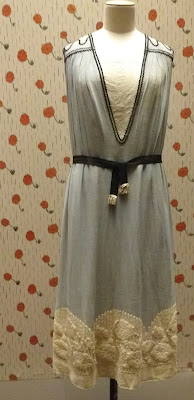 |
| Paul Poiret: Robe Delphinium, dite 'Robe Bonheur' (Delphinium dress, known as 'Happiness dress' 1912 Palais Galliéra |
 |
Paul Poiret: Corsage Les Fleurs et faluche ca 1915 (Flowers corsage and faluche hat)
|
Poiret, inspired by Viennese workshops, created his own in 1911 which employed young women from modest backgrounds to create motifs which were transferred to fabrics, wallpaper and ceramics. Named after his daughter Martine, the atelier had an outlet boutique at 83 rue du faubourg St Honoré.
His 'minaret' dress brings an exotic touch:
 |
| Paul Poiret: Minaret ensemble 1913 Satin. Private Collection |
The present exhibition takes us through the dark period of World War 1. The designer Paul Poiret joined the Infantry and created an overcoat for the soldiers that was economical on material and labour. It was adopted by the French army but later was found to have certain faults- no pockets for ammunition and the legs were insufficiently covered:
 |
| Paul Poiret Capote de troupe (Troop overcoat) 1915 Péronne, Historial de la Grande Guerre |
It is interesting to see photos of Paris during World War 1- for example the arc de triomphe protected by sandbags against bombardments:
 |
| Photo by Fernand Cuville: Arc de Triomphe protected against bombardments 1918 Musée Albert-Kahn |
While World War 1 was taking its toll of young lives, an avant-garde ballet called "Parade" was surprising audiences at the Chātelet theatre in 1917. Based on a text by Jean Cocteau and music by Eric Satie, the costumes were designed by Picasso in whimsical Cubist style:
 |
| Costumes for the ballet "Parade" by Picasso 1917 (remade in 1979) |
Short extracts of that unconventional ballet are on show in the exhibition (also available on You Tube) The brand new Théâtre des Champs Elysées was opened in 1913, built using the revolutionary new material concrete, with decorative sculptures by Antoine Bourdelle:
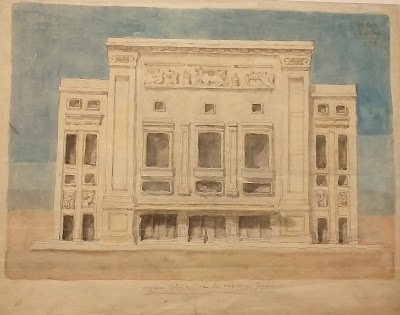 |
| Antoine Bourdelle: Eleventh study of the 2nd facade |
It was the setting for some avant-garde ballets by the ballets Suédois; one shocked audiences by having the dancers wear flesh coloured body stockings and perform to the music of Eric Satie. The ballets russes took over and Diaghilev continued the scandal with Igor Stravinsky's 'Rite of Spring'. An earlier work by Igor Stravinsky -The Firebird- was acclaimed at the Paris Opera House:
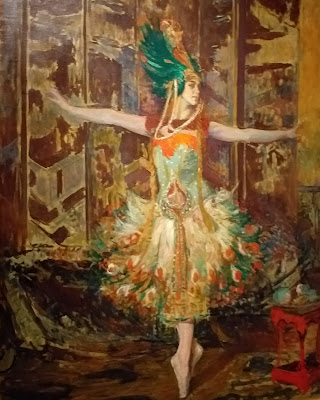.jpg) |
| Jacques-Emile Blanche: Tamara Karsavina dancing the "Firebird" 1910 Musée de l'Opéra |
Anna Pavlova refused to dance such an avant-garde role, so it was taken on by Tamara Karsavina, aided by its composer Igor Stravinsky, portrayed here by Jacques-Emile Blanche:
 |
| Jacque-Emile Blanche: Igor Stravinsky 1915 Musée de la musique-Philharmonie de Paris |
After the Great War, as it was known- the war to end all wars- the mood of Paris lifted and an exhilarating period followed- les années folles.
In 1925 the arrival on the stage of the Théâtre des Champs Elysées of Josephine Baker wowed the whole of Paris. She never looked back. Artist Kees van Dongen was one of many to portray her:
 |
| Kees van Dongen: Josephine Baker 1925 ink and watercolour Musée Singer Laren |
Cocteau also gave a rendering in ink of the exciting performer from America, embodying the new jazz age:
 |
| Jean Cocteau: Josephine Baker Private Collection |
A Cocteau self portrait demonstrates the equivocal nature of the artist:
 |
| Jean Cocteau: Autoportrait "Ecrivez lisiblement" (Self portrait "Write Legibly") |
1919 lithography. Musée Jean Cocteau, Menton
Several photos and maquettes relate to the Paris Decorative Arts Exhibition of 1925 which gave rise to the expression "Art-Deco". The "Collectors'" Pavilion on the Esplanade des Invalides was a model of geometric architecture:
 |
| Collector's Pavilion, photo by Roger Dumas 1925 |
On loan from the Museum of Decorative Arts, the interior door of that pavilion is a beautiful piece of workmanship, made of silver and forged iron:
 |
| Edgar Brandt: Les Bouquets (The Bouquets) interior door of Collector's Pavilion 1925 |
Simplified geometric shapes, with often the most refined craftsmanship was a characteristic of fashions and furniture alike, leading to many orders from customers:
 |
Atelier Martine: Cambodian chair ca 1925 London, Crosta Smith Gallery and
Paul Poiret: Daytime dress ca 1920 Fondation Azzédine Alaïa |
The exhibition contains some exquisite creations by couturiere Jeanne Lanvin, who ran a huge fashion business employing over 800 people in 1925:
 |
| Jeanne Lanvin: cocktail dress |
A big favourite and suitable ending to the show is Pompon's polar bear, with his streamlined iconic features:
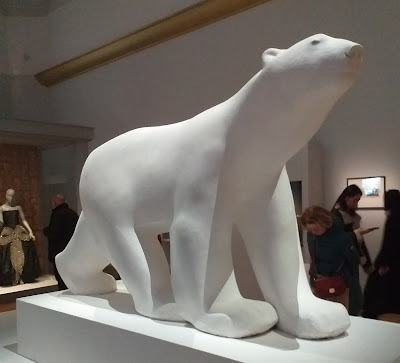.jpg) |
| François Pompon: Ours blanc (Polar bear) ca 1923 Musée d'Orsay |
The Eiffel tower appeared rather dark and invisible aganst all the night lights of the 1925 fair, so Fernando Jacopozzi was commissioned to brighten it up. Using 250,000 light bulbs, he produced an amazing light display which has only been rivalled in recent times:
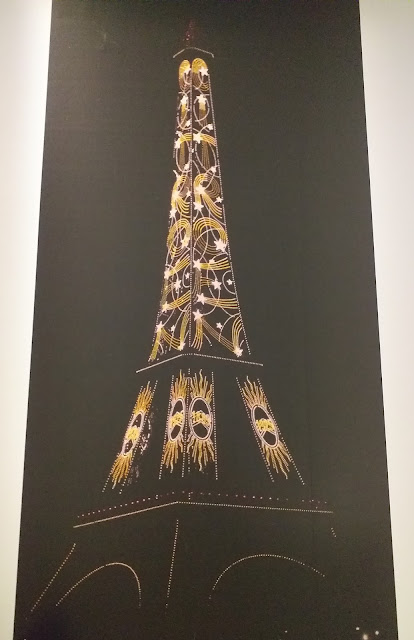 |
| Fernando Jacopozzi: Illumination of the Eiffel Tower 1925 |
Le Paris de la Modernité. 1905 -1925
Exhibiton at the Petit Palais, avenue Winston Churchill, 75008 Paris
From 14th November 2023 to 14th April 2024
Metro: Champs-Elysées-Clemenceau.
***************








.jpg)









.jpg)







.jpg)

.jpg)

Comments
Post a Comment